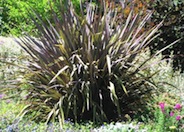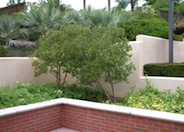
Common name:Hollywood Twisted Juniper
Botanical name:Juniperus chinensis 'Kaizuka'
The dark green foliage on the branches of this Juniper start in a narrow cone shape when young but open up gracefully when older. Its twisted looking branches resemble flames. It may grow 15' tall in 15 years. Over time, the branches may lean to one side. Junipers are highly combustible plants.

Common name:New Zealand Flax, Purple
Botanical name:Phormium tenax 'Atropurpureum'
Phormium tenax 'Atropurpureum' is an evergreen perennial. Big, dramatic plant composed of many swordlike, stiffly vertical leaves can reach 5' tall. Leaves are purple red. Flowers stems reach high above leaves, bearing clusters of 1"-2" blossoms in dark red.

Common name:Snow-In-Summer
Botanical name:Cerastium tomentosum
Masses of snow white flowers highlight this plant during the early summer season.

Common name:Strawberry Guava
Botanical name:Psidium cattleianum
This shrub will reach 12' tall and has medium sized, glossy green leaves with white flowers that bloom in the summer.

Common name:Waxleaf Privet
Botanical name:Ligustrum japonicum 'Texanum'
This dense evergreen shrub of an upright habit is capable of growing as a shrub or small tree. Its dark green, leathery leaves are opposite those of a simple evergreen plant.

Common name:Tree Roses
Botanical name:Rosa Tree varieties
Tree roses are actually shrubs that have been grafted or grown in a way that looks like a tree, ie with a trunk. Tree roses can be floribundas, hybrid teas, or grandifloras. They are typically used as specimen plants. Make sure the plant is tied to a stake in case of strong winds.

Common name:Sea Lavender, Statice
Botanical name:Limonium perezii
This mounding shrub will reach about 3' high and has large, dark green leaves with small blue and purple flowers that bloom in spring and summer.

Common name:Blackwood Acacia, Black Acacia
Botanical name:Acacia melanoxylon
Blackwood Acacia is a fast growing tree reaching 30'-50' with 20'-30' spread. It has white flowers that are noticeable from March through May. It can work as a windbreak and has wonderful biomass value. Its leaves are dark green and narrow, with flowers that can be creamy to straw-colored, growing in short clusters and appearing in March or April.
| Designer: | Snow White's Garden |
Photographer: GardenSoft |
Soils and Compost:
Incorporate compost 6" into your soil to retain water, reduce compaction, feed earthworms, and provide valuable nutrients to your plants.
Water Saving Tip:
Integrated Pest Management:
Remove irrigation water and fertilizer from areas where you don't want weeds to grow.
